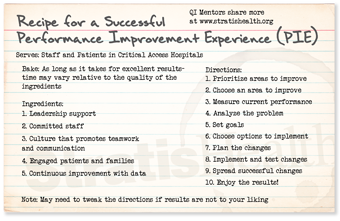“Going into this, we knew it was going to shake everything up – COVID’s actually given us some leverage to go back to our managers, and say, ‘Let’s think in a rounder way about how we address risk management issues or quality issues.’”
August 2020
In this episode, Mariah Hesse from, Sparrow Clinton Hospital in St. Johns, Michigan, and Ben Power from Barrett Hospital & HealthCare in Dillon, Montana, discuss the impact COVID-19 had on their hospitals with regards to quality improvement (QI), and how they adapted their QI work accordingly.
Want to take Quality Time with you on the go? You can subscribe to the podcast version through your favorite streaming service.
Insights from your QI Mentors
Recommended resources
Select resources recommended by the QI Mentor Program.
- CAH Quality Prioritization Tool. A part of the Quality Improvement Implementation Guide and Toolkit for CAHs, the prioritization tool assists CAH quality and patient safety leaders in making decisions related to patient safety and quality investments, recognizing that it’s not always feasible to incorporate every topic into the overall quality and patient safety plan at one time.
- Crisis and Emergency Risk Communication Manual and Tools. This manual describes core emergency and crisis communication principles and how they apply to each phase of an emergency. Tools are available to prepare communication plans or use during a crisis.
- Rural Response to Coronavirus Disease 2019 (COVID-19). This guide will help you learn about activities underway to address COVID-19 with a focus on rural communities.
Second helping of PIE?
If you would like more information
from the national virtual Quality
Improvement Mentors on their
performance improvement
experience in critical access
hospitals, please submit this
short form.
| QI Mentor favorite featured pie recipe: Fresh Strawberry Pie |
 |
Transcript: The Impact of COVID-19 on Quality Improvement
Note: Quality Time: Sharing PIE is produced for the ear and designed to be heard. This transcript is intended to augment the recording.
Narrator: Welcome to Quality Time: Sharing PIE — when experienced quality improvement staff — from critical access hospitals across the country — sit down together and serve up their lessons learned — strategies, tips, and ideas — from their in-the-field performance improvement experience.
Sarah: Hi – I’m Sarah Brinkman from Stratis Health. Thank you for listening to this session of Quality Time: Sharing PIE. We’re joined today by Quality Improvement Mentors Mariah Hesse from Sparrow Clinton Hospital in St. Johns, Michigan, and Ben Power from Barrett Hospital & Healthcare, Dillon, Montana! I’m happy you two can sit down with me today to talk about the role and importance of quality improvement during the COVID-19 pandemic.
Sarah: There is so much to talk about with regards to the impact of COVID-19 on health care providers, our focus today is understanding the impact it had on quality improvement at your critical access hospitals, and what lessons you hope to carry into the future. To start, can you tell us about some of the quality improvement tools, processes, and technologies you leaned on as the coronavirus forced rapid change at your facility?
Mariah: Some of the tools that we used at our organization regarding quality during the COVID pandemic was our Plan-Do-Study-Act, and if something wasn’t working and we assessed it, we would change that up and review. However, I think during the last three months, it was very rapid, everything was sort of accelerated and things still worked out, and we’d be resilient and flexible change that course.
We did use the Incident Command Structure, and we had section chiefs and then we had leaders under those section chiefs. So they really took a hold of a lot of those best practices and guidelines from planning to operations. And I think when you have that quick turnaround and that need, our team was there. And I think that all plays a part in quality, patient safety, and also caregiver safety. I don’t know if you experienced the same thing or not, Ben.
Ben: We did. There’s definitely an emphasis on trying to get people information in a way that’s useful to them in their processes right now. And it’s always been an emphasis that we’ve had, but it became really critical right now. And the Incident Command comes into that, but technology tools come into that as well. There were folks that had considerably less reliance on email, and we wanted to push things out to them through email so that we didn’t have to physically be in their work environment for obvious reasons.
Ben: One of the big lessons that I’ve learned from that, is never assume that because you sent the last email that that’s okay. [laughter] Just go ahead, pick up the phone and call them. Or send another email.
Ben: And also exploring the resources we already have within our own electronic health records to do data sharing, to make sure that departments are getting hands-on access to their own information has really given us some leverage in what we’re doing to be able to not just throw data at them about quality improvement but to hopefully design smarter tools that we can then share with them, get some feedback, and continue to improve, and then put the tools in their hands to be able to create their own information that they need for quality improvement.
Mariah: Also, I think our IT did a wonderful job as a health system of giving access to staff to work remotely from home. And what is that process and the privacy and everything else that goes with all that? And equipment provided. And how that phased in approach. It’s just is amazing when you reflect back on the past three months how much work was done. IT’s done tremendous working through the pathways and order sets and flags and making sure it’s communicated well for all staff when they entered that EMR record.
Sarah: Recognizing the rapid pace of changes being made, and the need to get team members information and resources in a way that’s useful to them, we asked the Mentors to talk about how they are effectively managing that communication flow.
Mariah: Going in the future, where’s that one source of truth that it can be housed and it’s very easily accessible. Because like you said, the frontline caregivers, many of them, they do not have time to check their emails. So we’re posting Huddle Helpers and making binders and putting the most version and dating all these new practices or guidelines.
Ben: Yeah. That’s a great point, and what do we do as far as going forward because these tools have really helped us at this point, and then the question becomes we’ve saved a lot of time, we’ve shortened meetings, and we’ve definitely reduced the number of meetings that we’ve had to have, and that’s been one of the unintentionally positive outcomes that we’ve had from the COVID crisis. But how can we then take that and apply it going forward to continue to add that benefit even when we don’t have the exceptional pressure of the pandemic forcing us into it.
Sarah: COVID-19 will continue to shift the financial and operational priorities of critical access and other hospitals for the near future. How are you seeing that play out in your facilities and what adjustments are you making in your quality work to accommodate those shifts?
Mariah: Financially we all have been hit, and what does that look like post-pandemic. Because COVID is not going away, you’re right. But what will the volumes look like?
Mariah: Probably most of us have seen that across the country, and Ben’s shaking his head too, yeah. The E.D. volumes are changed. It will be interesting to see over the next three, six months what those E.D. volumes will be.
Mariah: Also, I think, we do have a patient-family advisory council. And our PFAC, we’ve canceled all of our meetings since like February, so just hopefully we’re going to resume those back in August, and it may even be remotely, but those were canceled, and we had a lot of focus going on care transitions and coordination of care with our PFAC members.
Ben: So we’ve had to push some things back a bit, have some delays, just due to staffing and safety. I feel like in certain ways, we have learned what things… not so much what things are expendable, but the timing of such things might be more flexible than we originally intended for it to be.
Sarah: In this segment, our Mentors talk about simultaneously supporting staff while encouraging them to own the quality improvement work in their departments, as well as some of the unexpected positives from the pandemic that may help them sustain quality improvement efforts going forward.
Mariah: There was a lot of emotions. A lot of fears, a lot of anxiety. It’s those fears of the unknown at first and how you relieve those fears. One thing that really helped with us was, we did communicate on a regular basis, weekly basis.
Mariah: Relationships and communication is a key.
Ben: So we’re trying to avoid meetings. We’re trying to avoid being in the space where the work’s being done. And it actually, it’s had some really positive things come out of it as far as bringing the onus for improvement back to the people who are doing the work, not because we want to place additional work on them, but because…
Mariah: They live it, they breathe it… (crosstalk in Ben’s clip, can’t remove)
Ben: …right, It is not my responsibility or my privilege to be an expert in the work that they do, and if I try to change the work that they do, I have a lower possibility of success than if they change it. And I’m certainly willing to provide structure and administrative support for that and leverage when they need it. But we’re able to sort of bring this back to managers and staff and say, “This has always been something that we’ve needed your support and input and control in, and we need you to step up and run with this.”
Mariah: I think that’s a positive thing that came out of the COVID. I think it did break down a lot of silos across our health system, even across our own organization from department to department, helping each other cross-training, working together as a team.
Ben: You know, we had a near-harm event in the emergency department that the source was a medication in the wrong place in the Pyxis. So we had a look-alike medication, perhaps, or something else that caused a mis-stock. So we fixed that there, but does the same issue exist in the Pyxis upstairs, or is there a similar look-alike issue that we need to fix? Are we asking that question? So trying to train the managers into thinking about that and thinking about issues, not just as an immediate fire that needs to be put out, but as a flag that says there’s a risk that exists, and we need to ensure that the entire risk is being addressed. So COVID’s really given us actually some leverage to go back to our managers, and say, “Let’s think in a rounder way about how we address risk management issues or quality issues.”
Mariah: I think the key is, like you said, it has to be back on owners of the department, but also those managers and leaders have to look broadly across the system. We are too small in critical access hospitals in rural communities to look only in your own tunnel. We’ve got to look house wide. [Absolutely [Ben]. And I think if you involve the front line and the bedside staff, that’s where you get your engagement and hopefully communication because there’s much more engagement and compliance when it comes from each other than top-down, bottom-down. It’s with each other. Absolutely [Ben].
Mariah: One thing that I think occurred during COVID is when you were involved in your incident command structure or your sections, a lot of other things were put on pause. So you had that time, and you had that autonomy, and you had that administrative support to say, “This is your focus. These are our goals. We need it done quickly.” So going forward, looking at quality, did we really put that little sub-committee or that team together to move forward quickly like that? For example, the discharge process for care transitions. “Oh yeah, I wanted to update these medication cards that we give to family.” Well that’s always put on the back burner, but if you really had the time and that small group of people work on it for a week straight, you would have it done.
Ben: I think one thing that we need to do is show them results. We need to make sure that they can see that they are getting what they want from this because in the end, there’s several things that they w ant. Obviously, they want these issues to not recur. And the other thing that they want is fewer emails about issues. So that’s actually quite valuable to them, to have fewer things to read and respond to.
Mariah: But even sustaining like hand hygiene compliance or PPE compliance, and how do you do that? You look at direct observations, self-monitoring, coaching, just-in-time coaching, and all those play in part, but it really goes back to that transparency as well, the communication. So they see the data, and they realize what the data means, I think, is the key, too. Because we have seen a better compliance of course with PPE and hand hygiene.
Sarah: Any other examples of ways you’re working to engage staff in quality improvement work that you’ll carry beyond the pandemic?
Ben: I think we need to celebrate successes, some of which are a little difficult. Some folks in the organization are still a little bit standoffish about openly discussing harm events, but putting those into, we’ll usually put them into the weekly or bi-weekly newsletter that goes out to everyone, we’ll put some sort of success story from a lean project.
Mariah: I think focusing on the why is very important, and we do start all of our meetings and we have a standard agenda item that is a safety moment and we share those harms or those near-misses or good catches. And I think that does play a key, and we continued to do that throughout the COVID pandemic too.
Sarah: To close out this Quality Time session, we asked the Mentors what has most surprised, inspired or motivated them, and what does Quality look like during this unprecedented time.
Mariah: There are so many unsung heroes, and we talk about essential workers during this COVID time. Every single person that is in our hospital, our practices, our providers have been valuable, unsung heroes many of them, and very essential. They all play a key part from EVS, supply chain.
Ben: I think the question, “What does quality look like” is a really interesting one because going into this, we knew it was going to shake everything up – and it has, it actually produced some really good things– and we could have predicted that we would have to revise our strategy for quality.
Narrator: Quality Time: Sharing PIE was produced by Stratis Health, with funding through Rural Quality Improvement Technical Assistance — a program supported by the Federal Office of Rural Health Policy — to help critical access hospitals across the country move from quality reporting to quality improvement. Want another serving of PIE? Or have a burning question about rural quality improvement? Visit the QI mentors web page.




